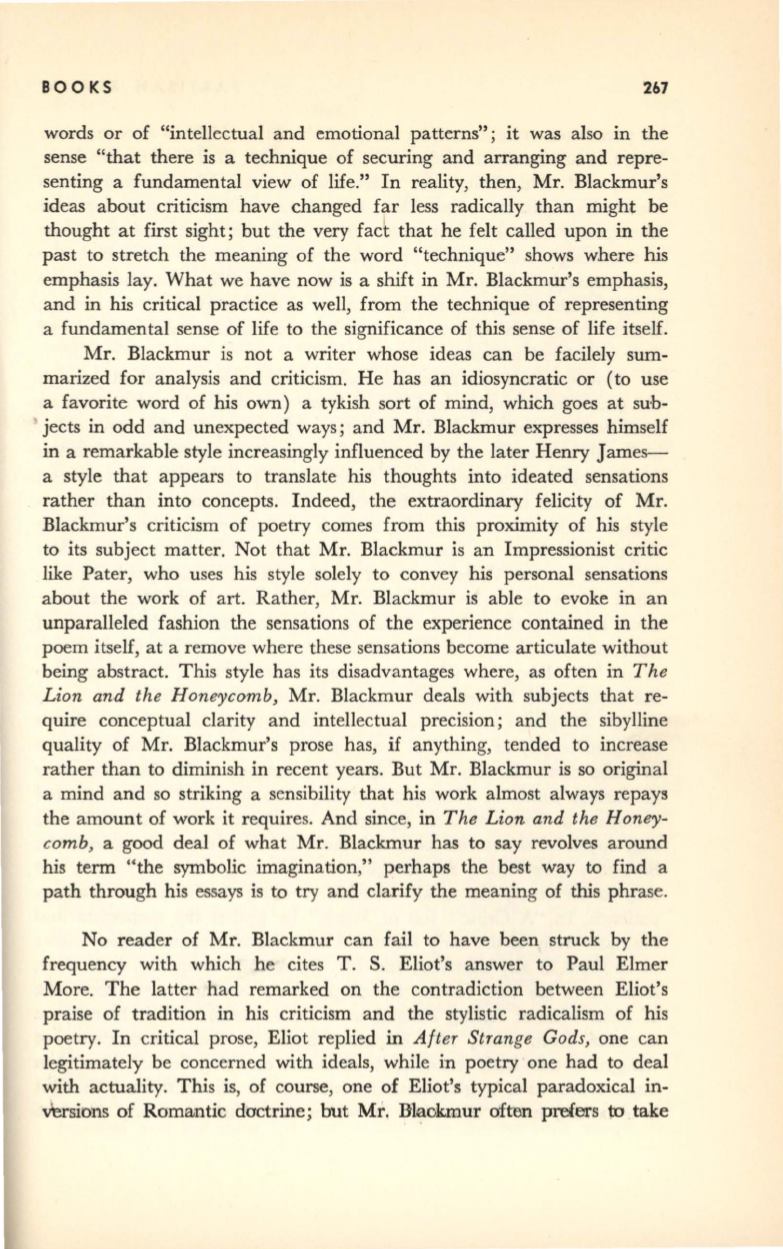
BOOKS
267
words or of "intellectual and emotional patterns"; it was also in the
sense "that there is a technique of securing and arranging and repre–
senting a fundamental
view
of life." In reality, then, Mr. Blackmur's
ideas about criticism have changed far less radically than might be
thought at first sight; but the very fact that he felt called upon in the
past to stretch the meaning of the word "technique" shows where his
emphasis lay. What we have now is a shift in Mr. Blackmur's emphasis,
and
in
his
critical practice as well, from the technique of representing
a fundamental sense of life to the significance of this sense of life itself.
Mr. Blackmur is not a writer whose ideas can be facilely sum–
marized for analysis and
criticism.
He has an idiosyncratic or (to use
a favorite word of his own) a tykish sort of mind, which goes at sub–
jects in odd and unexpected ways; and Mr. Blackmur expresses himself
in a remarkable style increasingly influenced by the later Henry James–
a style that appears to translate his thoughts into ideated sensations
rather than into concepts. Indeed, the extraordinary felicity of Mr.
Blackmur's criticism of poetry comes from this proximity of his style
to its subject matter. Not that Mr. Blackmur
is
an Impressionist critic
like Pater, who uses his style solely to convey his personal sensations
about the work of art. Rather, Mr. Blackmur is able to evoke
in
an
unparalleled fashion the sensations of the experience contained in the
poem itself, at a remove where these sensations become articulate without
being abstract. This style has its disadvantages where, as often in
The
Lion and the Honeycomb,
Mr. Blackmur deals with subjects that re–
quire conceptual clarity and intellectual precision; and the sibylline
quality of Mr. Blackmur's prose has, if anything, tended to increase
rather than to diminish in recent years. But Mr. Blackmur is so original
a mind and so striking a sensibility that his work almost always repays
the amount of work it requires. And since, in
The Lion and the Honey–
comb,
a good deal of what Mr. Blackmur has to say revolves around
his term "the symbolic imagination," perhaps the best way
to
find a
path through his essays is to try and clarify the meaning of this phrase.
No reader of Mr. Blackmur can fail to have been struck by the
frequency with which he cites T. S. Eliot's answer to Paul Elmer
More. The latter had remarked on the contradiction between Eliot's
praise of tradition in his criticism and the stylistic radicalism of his
poetry. In critical prose, Eliot replied in
After Strange Gods,
one can
legitimately be concerned with ideals, while in poetry one had to deal
with actuality. This is, of course, one of Eliot's typical paradoxical in–
Versions of Romantic doctrine; but Mr, Blaokmur often prefers
to
take


